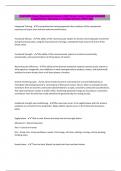NASM PES Exam | Questions & Answers (100 %Score) Latest Updated 2024/2025
Comprehensive Questions A+ Graded Answers | 100% Pass
Integrated Training - ✔✔A comprehensive training approach that combines all the components
necessary to help a client achieve optimum performance.
Functional efficacy - ✔✔The ability of the neuromuscular system to monitor and manipulate movement
during functional tasks, using the least amount of energy, creating the least amount of stress of the
kinetic chain.
Functional Strength - ✔✔The ability of the neuromuscular system to contract eccentrically,
isometrically, and concentrically in all three planes of motion.
Neuromuscular efficiency - ✔✔The ability of the (human movement system) neuromuscular system to
allow agonists, antagonists, and stabilizers to work synergistically to produce, reduce, and dynamically
stabilize the entire kinetic chain in all three planes of motion.
stretch-shortening cycle - ✔✔an active stretch (eccentric contraction) of a muscle followed by an
immediate shortening (concentric contraction) of that same muscle. Occurs when an activated muscle
transitions from an eccentric contraction (deceleration) to a rapid, concentric contraction (acceleration).
The rapid contraction creates a stretch reflex, shortening potential energy use to produce a concentric
contraction more forceful than could otherwise be generated by the resting muscle.
traditional strength and conditioning - ✔✔Often exercises occur in the sagittal plane with the primary
emphasis on concentric force production. Many athletic injuries occur in the frontal and transverse
plane.
Sagital plane - ✔✔*Side to side. Bisects the body into left and right halves
Movement = flexion/extension
Axis = Coronal or frontal
Ex's = bicep curls, tricep pushdown, squats, front lunge, calf raise, walking, running, vertical jumping,
climbing stairs
frontal plane - ✔✔*Front to back. Bisects the body into front and back halves
,Movement = adduction, abduction, lateral flexion, eversion/inversion
Axis = anterior/posterior
Ex's = side lateral raises, side lunges
transverse plane - ✔✔* Horizontal bisection of the body into upper (superior) and lower (inferior)
halves.
Movement = internal/external, rotation, horizontal adduction/abduction
Axis = longitudinal
Ex's = cable rotations, transverse lunges, throwing, golfing, swinging a bat
extension - ✔✔Increases the angle of a joint. Occurs when the relative angle between two adjacent
segments increases.
Flexion - ✔✔Decreases the angle of a joint. Occurs when the relative angle between two adjacent
segments decreases.
Abduction - ✔✔Movement away from the midline of the body. An increase in adjacent angle between 2
adjoining segments.
ankle movements - ✔✔Dorsiflexion (flexed foot)
plantar flexion (pointed foot/extension)
Adduction - ✔✔Movement toward the midline of the body. Decrease in angle.
Stabilizers - ✔✔Muscles that minimize unwanted movement while the agonist (prime mover) and
synergists perform the movement pattern.
Ex - transverse abdominis, internal obliques, multifidus & deep erector spinae stabilize the LPHC during
functional movements while prime movers perform functional activities.
Synergist - ✔✔muscles that aid a prime mover during functional movement patterns. Ex. the hamstring
& the erector spinae are synergistic with the gluteus maximus during hip extension.
,Antagonists muscles - ✔✔Muscles that act in direct opposition to the prime mover (agonist) . Ex. -
biceps and triceps, psoas is the antagonist to the gluteus maximus.
Agonists - ✔✔Muscles that work as the prime mover. Ex. gluteus maximus is the prime mover for hip
extension.
motor behavior - ✔✔HMS's response to internal & external environmental stimuli.
Motor Control - ✔✔How the central nervous system integrates internal and external sensory
information with previous experiences to produce a motor response.
Motor Learning - ✔✔Integration of motor control processes through practice and experience, leading to
a relatively permanent change in the body's actual capacity to produce skilled movements.
Lateral System - ✔✔Comprised of the Gluteus Medius,
TFL, Adductor complex, Contralateral Quadratus Lumborum. FRONTAL PLANE & pelvis - femoral
stability.
motor development - ✔✔The CHANGE in motor skill behavior OVER TIME throughout the lifespan.
Anterior Oblique Subsystem (AOS) - ✔✔Subsystem of the global movement system composed of the
internal and external obliques, the adductor complex, and the hip external rotators. The synergistic
coupling of the AOS creates stability from the trunk, through the pelvic floor, and to the hips. It
contributes to rotational movements, leg swing, and stabilization. The AOS and POS work together in
enabling rotational force production in the TRANSVERSE PLANE.
Deep Longitudinal Subsystem (DLS) - ✔✔Subsystem of the global movement system that includes the
peroneus longus, anterior tibialis, long head of the biceps femoris, sacrotuberous ligament,
thoracolumbar fascia, and erector spinae. These muscles work together to create a contracting tension
to absorb and control ground reaction forces during gait.
, Prior to heel strike, the biceps femoris activates to eccentrically decelerate hip flexion & knee extension.
Global muscular system (Movement System) - ✔✔Muscles responsible predominantly for movement,
important in transferring and absorbing forces form the upper and lower extremities to to the pelvis,
and consist of more superficial musculature that originates from the pelvis to the rib cage, the lower
extremities, or both
Rectus abdominis, external obliques, erector spinae, hamstrings, gluteus max, latissimus dorsi,
adductors, quads & gastroc.
Stabilization system (Local Muscular) - ✔✔The muscles & joints whose primary function is to provide
joint support and stabilization; also known as the local muscular system.
Transverse abdominis, lumbar multifidus, internal obliques, diaphragm & pelvic floor muscles.
length-tension relationship - ✔✔as length increases, tension decreases
concentric muscle action - ✔✔Developing tension while a muscle is shortening; when developed tension
overcomes a resistive force.
"a positive". Cloud, collapsing
isometric contraction - ✔✔muscle tenses but does not shorten. When the contractile force is equal to
the resistive force.
eccentric muscle action - ✔✔An eccentric muscle action occurs when a muscle develops tension while
lengthening; when resistive force overcomes developed tension.
"A negative"
lowering phase of a resistance exercise. Elongate




